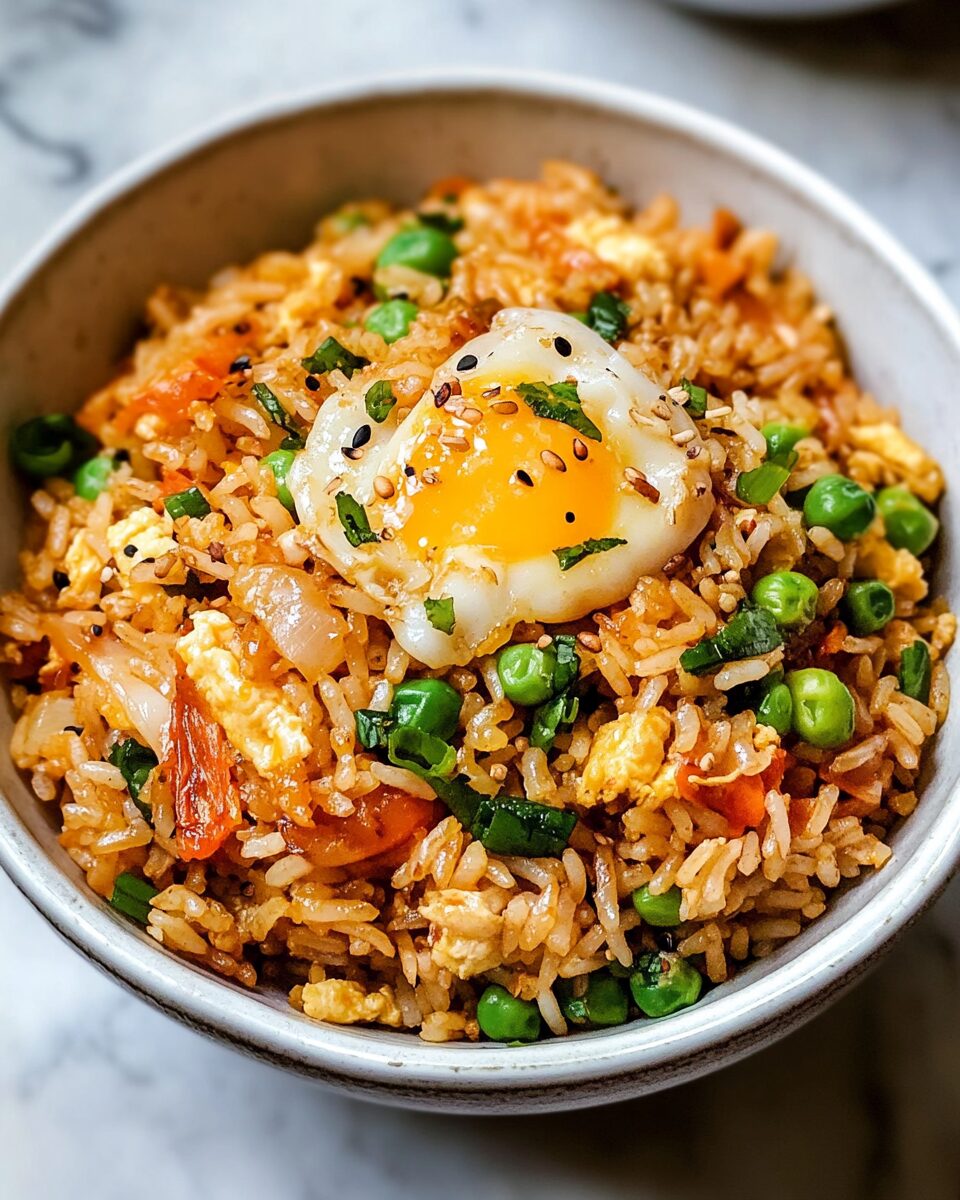The bold, tangy flavor of well-fermented kimchi paired with steaming, slightly crispy rice makes this Kimchi Fried Rice the ultimate Korean comfort dish. Topped with a runny fried egg and a sprinkle of sesame seeds, it’s a delicious way to turn leftovers into a crave-worthy meal.
Perfect for those busy weeknights or when you want to add a spicy kick to your mealtime, this dish comes together in minutes and tastes even better than takeout. Whether you’re a kimchi lover or just curious about Korean flavors, this recipe is a must-try in your home kitchen.
Full recipe:
Ingredients:
-
2 cups cooked short-grain rice (preferably a day old)
-
1 cup well-fermented kimchi, chopped
-
1/4 cup kimchi juice
-
2 tablespoons vegetable oil
-
1/2 onion, finely chopped
-
2 green onions, chopped (separate white and green parts)
-
1 tablespoon gochujang (Korean red chili paste)
-
1 teaspoon soy sauce
-
1/2 teaspoon sesame oil
-
1 egg (optional, for topping)
-
Roasted seaweed strips (gim), for garnish
-
Sesame seeds, for garnish
Directions:
-
Heat the vegetable oil in a large skillet or wok over medium heat. Add chopped onion and the white part of the green onions. Sauté until translucent.
-
Add the chopped kimchi and cook for 3–4 minutes until it starts to caramelize slightly and becomes fragrant.
-
Stir in the gochujang, kimchi juice, and soy sauce. Mix well and cook for another 2 minutes.
-
Add the rice and break up any clumps. Mix thoroughly to combine with the kimchi mixture. Stir-fry everything together for 4–5 minutes until heated through.
-
Drizzle the sesame oil and toss to coat evenly. Adjust seasoning to taste.
-
In a separate pan, fry the egg sunny-side up (or your preferred style).
-
Serve the kimchi fried rice hot, topped with the fried egg, green onion (green part), roasted seaweed strips, and sesame seeds.
Prep Time: 10 minutes | Cooking Time: 15 minutes | Total Time: 25 minutes
Kcal: 410 kcal | Servings: 2 servings
The Heart of the Dish: Kimchi
Kimchi is a fermented vegetable dish, most commonly made from Napa cabbage and Korean radishes, seasoned with chili flakes, garlic, ginger, and various other spices. It has been an essential part of Korean cuisine for centuries, valued not only for its intense flavor but also for its health benefits.
In the context of Kimchi Fried Rice, the kimchi used is usually more fermented or “overripe,” which means it has developed deeper sourness and a funkier umami profile. This aged kimchi becomes the soul of the dish, infusing the rice with a deep, tangy heat and enhancing every bite with layers of complexity.
Cooking kimchi mellows its sharpness and transforms its flavor profile — it becomes sweeter, smokier, and richer. When stir-fried, it releases juices that soak into the rice, creating a vibrant, reddish-orange hue and intense flavor throughout.
Cultural Significance and Popularity
In Korea, Kimchi Fried Rice is considered a “fridge-cleaner” meal. It’s often made at the end of the week or when groceries are low, utilizing leftover rice, slightly wilted vegetables, and overripe kimchi. This frugal, no-waste approach is deeply embedded in Korean culinary tradition and reflects the value placed on resourcefulness and minimalism.
Despite its humble beginnings, Kimchi Fried Rice has gained international popularity. It’s featured in restaurants around the world — from street food stalls in Seoul to trendy fusion spots in Los Angeles and London. With the global rise in interest in Korean food and pop culture, dishes like this have found enthusiastic new audiences.
What makes this dish even more special is its place in the daily life of Koreans. It’s not a special-occasion dish but rather a comfort food eaten alone at home, shared with family, or served as a quick, satisfying lunch.
Health Benefits of Kimchi Fried Rice
While fried rice isn’t always associated with health, Kimchi Fried Rice is surprisingly nutritious when made thoughtfully. Here’s why:
-
Probiotics: Thanks to the fermentation process, kimchi is loaded with probiotics — beneficial bacteria that support gut health and digestion.
-
Antioxidants and Vitamins: Kimchi contains garlic, chili, and vegetables that are rich in vitamins A, B, and C, as well as antioxidants that may help reduce inflammation.
-
Low Waste Cooking: Using leftovers reduces food waste and allows you to repurpose ingredients that might otherwise be discarded.
-
Customization: You can make it healthier by using brown rice, reducing oil, or adding more vegetables or lean proteins like tofu or chicken.
In moderation and with quality ingredients, Kimchi Fried Rice can be part of a balanced diet.
Ways to Customize Kimchi Fried Rice
One of the joys of Kimchi Fried Rice is how flexible it is. While the base is rice and kimchi, the variations are endless:
-
Protein Options: You can add spam, bacon, ground beef, tofu, shrimp, or even canned tuna. In Korea, spam is particularly popular in this dish due to its salty, savory profile.
-
Vegetables: Add chopped carrots, peas, mushrooms, or spinach for added nutrition and texture.
-
Eggs: A fried egg on top is traditional and helps mellow the heat with its creamy yolk. You can also scramble an egg into the rice for a fluffier texture.
-
Cheese: Yes, cheese! Melty mozzarella on top is a Korean twist that adds indulgent richness and pairs surprisingly well with the spicy kimchi.
-
Spice Level: Control the heat with gochujang (Korean chili paste) or gochugaru (Korean chili flakes). Want it milder? Use less or none at all.
-
Toppings: Garnish with green onions, sesame seeds, roasted seaweed (gim), or even crushed seaweed snacks.
This customizability makes it an ideal recipe to suit various dietary needs or cravings — whether you’re going vegetarian, cutting carbs, or loading up on protein.
Tips for the Perfect Kimchi Fried Rice
To achieve restaurant-level Kimchi Fried Rice, here are some key tips:
-
Use Day-Old Rice: Freshly cooked rice can be too moist. Leftover rice from the fridge has dried out just enough to fry up nicely without getting mushy.
-
Chop Kimchi Finely: This allows it to blend better with the rice and spread the flavor more evenly.
-
Cook the Kimchi First: Sautéing the kimchi alone before adding rice helps deepen the flavor and releases its juices.
-
Don’t Overcrowd the Pan: Cook in batches if needed. Crowding the pan lowers the temperature, which can lead to soggy fried rice.
-
Add Sesame Oil Last: Sesame oil is fragile and can lose its aroma when overheated. Always add it at the end to preserve its nutty fragrance.
Fusion and Modern Takes
In recent years, chefs and home cooks alike have reimagined Kimchi Fried Rice in inventive ways. Some popular modern variations include:
-
Kimchi Fried Rice Burritos: Wrapping it in a tortilla for a Korean-Mexican mash-up.
-
Kimchi Fried Rice Balls: Shaped into spheres, coated in breadcrumbs, and deep-fried — a snackable twist inspired by Italian arancini.
-
Kimchi Fried Rice with Cheese Crust: A crispy, golden cheese layer formed by frying grated cheese directly onto the pan before adding the rice.
-
Kimchi Fried Cauliflower Rice: A low-carb, keto-friendly version using riced cauliflower instead of traditional rice.
These new forms have helped the dish appeal to different audiences and diets while keeping the core flavors intact.
Pairing Suggestions
To make Kimchi Fried Rice part of a complete meal, consider pairing it with:
-
Miso or Doenjang Soup: A light, fermented soup that complements the tanginess of the kimchi.
-
Korean Banchan (Side Dishes): Pickled radish, sautéed spinach, or Korean-style potato salad balance the strong flavors of the fried rice.
-
Cold Cucumber Salad: Crisp, cool, and slightly sweet — a refreshing counterpoint to the spiciness.
-
Iced Barley Tea or Soju: Depending on the mood, go traditional with a refreshing barley tea or indulge with a bit of Korean soju.
Conclusion: Why You Should Try Kimchi Fried Rice Today
Kimchi Fried Rice is more than just a quick meal — it’s a celebration of Korean flavors, a symbol of culinary resourcefulness, and a blank canvas for your creativity in the kitchen. Whether you stick to the traditional method or try a modern spin, you’re guaranteed a dish that’s hearty, flavorful, and deeply satisfying.
It captures the essence of comfort food: simple, unpretentious, and made with love — often from whatever’s left in the fridge. With just a few ingredients and a little heat, you can turn basic components into something truly magical.
So the next time you find yourself staring at a container of leftover rice and a jar of kimchi, remember: you’re only 15 minutes away from one of the best meals you’ll ever have.






